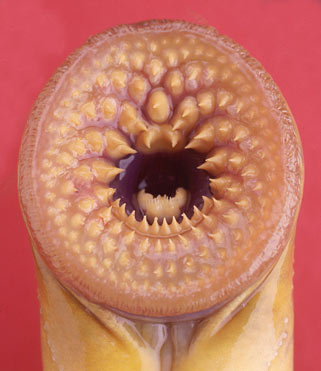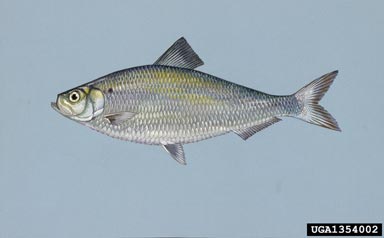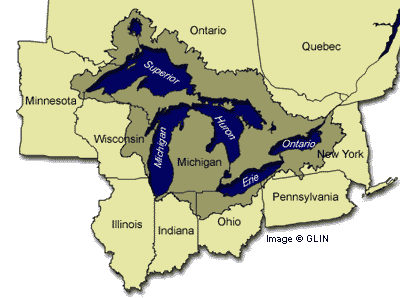


The Lakes
Homepage
History
Notable Michigan!
The Great Lakes
| The Great Lakes | The Lakes | Weather and Climate | Shipwrecks |
Great Lakes Facts and Trivia
 |
 |
 |
|---|
| Zebra mussls covering a sunkin grocery cart. | Lamprey found in Lake Superior,causes severe damage to fish. | Alewife multiply and block intake tubes at nuclear plants. |
|---|
Images from the EPA website http://www.epa.gov/glnpo/image/viz_iss4.html
Invasive Species that threaten the Great Lakes
"Over 160 invasive species threaten the ecological balance of the Lakes. They deprive fish of food, cause blooms of toxic algae, and foul boats, spawning areas and drinking water intakes. On average one new invasive enters the Great Lakes every eight months."
Zebra Mussels infestations in the Great Lakes and inland waters illustrate the severity of the problems stemming from invasive species introduction and spread. This non indigenous mollusk is an efficient filter feeder that competes with native mussels and impacts fish populations by reducing food and available spawning habitat. The utility and manufacturing industries around the region, depending on Great Lakes water for production, are expending substantial time and money cleaning intake and discharge pipes clogged by the zebra mussel. The US Fish and Wild Life Service estimates the economic impact to these industries to be $5 billion dollars over the next decade.
Approximately 10 percent of non indigenous aquatic species introduced into the Great Lakes have had significant impacts, both economic and ecological. The remaining 90 percent have potentially harmful impacts but are insufficiently researched and understood. Besides the zebra mussel, several other species have been particularly harmful. The invasion of the sea lamprey, a parasite that attaches to large fishes with a sucker mouth armed with teeth that consume flesh and fluid from its prey, has resulted in substantial economic losses to recreational and commercial fisheries. Protection of the Great Lakes fishery (both native and non indigenous species) from sea lamprey predation has required annual expenditures of millions of dollars to finance chemical control programs.
Alewife , introduced through the canal systems built in the Great Lakes, littered beaches each spring and altered food webs, causing increased water turbidity. These impacts subsided with the intentional introduction of salmonids that were stocked as predators to keep alewife populations under control. The ruffe, a small period fish, became the most abundant fish species in Lake Superior's St. Louis River within five years of its detection in 1986. Its range, which has expanded to Lake Huron, poses a significant threat to the lower lake fishery. Five years after first being observed in the ST. Claire River the round goby can now be found in all of the Great Lakes. The goby is considered undesirable for several reasons: It preys upon bottom-feeding fishes, overruns optimal habitat, spawns multiple times a season, and can survive poor water quality conditions.
An electric fence has been set up across the mouth of the Great Lakes across the Chicago Stationary and Ship Cannel in order to keep several invasive species of Asian Carp out of the area. Having voracious appetites, these fish feed upon native fish species to grow to 90 pounds and nearly four feet long.
 |
|---|
| Map of the great lakes Region |
|---|
 |
|---|
| Great Lakes Basin Map |
|---|
What borders what?
The Great Lakes are in North America, straddling the border of both the United States and Canada.If you stood on the moon, you could see the lakes and recognize the familiar wolf head shape of Lake Superior, or the mitten bounded by lakes Michigan, Huron and Erie.
Lake Superior is bordered by the states of Minnesota, Wisconsin, Michigan, and the province of Ontario.
Lake Michigan is the only lake that is fully contained within the United States, bordered by Wisconsin, Michigan, Illinois, and Indiana.
Lake Huron is bordered by the state of Michigan and the province of Ontario.
Lake Erie is bordered by the states of Michigan, Ohio, Pennsylvania and New York and the province of Ontario.
Lake Ontario is bordered by the state of New York and the province of Ontario.
The St. Lawrence River is not a Great Lake, but is an important part of the Great Lakes-St. Lawrence system, leading to the Atlantic Ocean. The St. Lawrence River is bordered by the state of New York and the provinces of Ontario and Québec
Informantion found at :www.great-lakes.net/.../greatlakesmap.html